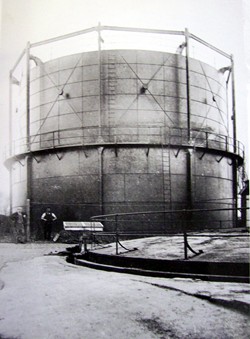|
THE GAS WORKS existed in Bourne for more than a century, producing coal gas
to provide light and heat for much of the town until electricity started to
compete because of its cleaner operation and safer installation. The first commercial gas works was built by the London and Westminster Gas Light and Coke Company in Great Peter Street in 1812 laying wooden pipes to illuminate Westminster Bridge with gas lights on New Year's Eve in 1813. Other gas works for towns and cities followed, the Bourne Gas Light and Coke Company being formed in 1840 with premises on a site at the top end of Eastgate. There were five trustees of the company, one of them being the vicar, the Rev Joseph Dodsworth, and £10 shares were issued to those who wanted a financial stake in the venture. The gasworks were erected at a cost of £2,000 and the enterprise prospered, the first project being the installation of gas lighting in the Abbey Church the same year followed by the erection of lamp standards to light the streets. The first street to be lit by gas had been Pall Mall in London in 1807 and by 1823 numerous towns and cities throughout Britain had followed suit. Costing up to 75% less than lighting produced by oil lamps or candles helped to accelerate its development and deployment. By 1859, gas lighting was to be found all over Britain and 1,000 gas works had sprung up to meet the demand for the new fuel. The brighter lighting which gas provided allowed people to read more easily and for longer, so helping to stimulate literacy and learning and speeding up the second Industrial Revolution. In 1868, it was necessary to enlarge the gasworks premises in what had become known as Gas House Yard to meet the demand and further extensions to installations were carried out in 1878 when new and much larger mains were laid as far as the Market Place. By this time, coal gas was being used for heating and lighting in homes, shops and business premises, as well as for street lighting and there were 56 public incandescent gas lamps at various points around the town. Kelly's Directory of Lincolnshire reported in 1885: "The town consists principally of four streets diverting from the Market Place, all remarkably clean and lighted with gas." In February 1898, the parish council, which was responsible for maintaining the street lighting at that time, asked the gas company to ensure that the lamps were lit on every dark evening and that they were left on all night on Saturdays and Sundays.
Explosions were not unknown, similar to that which occurred on the evening
of Friday 21st October 1898 at Mr Thomas Carlton's drapery shop in North Street.
There had been a small leakage of gas which seeped into a drain through a
grating at the roadside and a match thrown down by a passerby caused an
explosion. Damage was not extensive and the leak was located and repaired. There
were also breakdowns and when the engine at the gasworks failed in August 1915,
the Town Crier, Richard Lloyd, was called out on Sunday morning to alert
householders. The supply was cut off for 24 hours, causing much consternation
because housewives were about to start preparing Sunday lunch but they were
urged to light fires and use those for cooking instead while in the evening,
churches started services without lights although the gas supply was resumed
soon after they began. |
